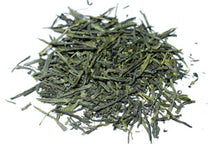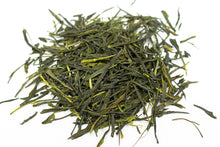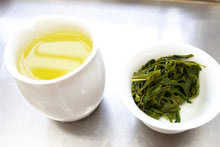Tsukigase Zairai does not give typical Japanese green tea flavor. Most of the Japanese green tea gives the typical sweet flavor. This flavor comes from the large amount of amino acid inside the tea leaf. Amino acid is produced if nitrogen-based fertilizer is applied on tea tree. The more nitrogen-based fertilizer is being applied, the faster the tea grows and more amino acid is composed. This amino acid is called theanine. When tea is baked at the finishing process called Shiage;, amino acid reacts with sugar and forms typical kind of flavor on account of Maillard reaction. It is the same mechanism as creating the aroma of hot cake.

Without nitrogen-based fertilizer, tea grows at very slow speed. Tea will then composes more polyphenols, and more minerals will be accumulated inside the leaf. Tsukigase Zairai is planted without applying any fertilizer. That's why it is rich in minerals and polyphenols. For this kind of tea, it gives very refreshing flowery flavor because it has very less amino acid. If you brew this tea with short infusion, the taste is just like Taiwan oolong tea.
Tsukigase is rich in red soil
Tsukigase Zairai Sencha is produced in Nara prefecture, at Tsukigase village. But recently due to the government's policy, this village was merged into Nara city. Tsukigase is developed along Nabari river (名張川). This river flows through Kyoto and finally reaches Osaka. The name of the river also changed from Nabari river to Kizu river and Yodo river when river runs through different places. In the history, the river was used for logistics. Naturally all tea gardens were developed along this river, and the city located at down stream was the main market of the tea. As I mentioned earlier, the down stream of this river is Kyoto. Historically the tea produced along this river, including Tsukigase Zairai Sencha, was sold as Uji Sencha. Only a few years ago, due to the changes of the regulations by health ministry in Japan, they stopped calling it Uji Sencha. Nowadays, tea produced in Nara is called Yamato Cha. Yamato is the Nara's ancient name, and once upon a time, it was the oldest capital city of Japan back in AC 794.

Tsukigase used to be the bottom of Biwa Lake
Tsukigase is situated at the border of three prefectures, Nara (奈良), Kyoto (京都) and Mie (三重). Once upon a time, the Bira lake (琵琶湖)was much larger than now. Tsukigase area was at the bottom of this lake. As time passed by, the land rose and formed the present geographical feature. This is the reason that Tsukigase is very rich in red clay. In fact, Tsukigase is very near to Iga and Shigraki. Both places are known to produce very fine red clay in the history. From Tsukigase, it takes only a few minutes to reach Iga. Tsukigase tea has such good quality is mainly because of the red clay.

However, in Tsukigase, the fine soil only exist in certain areas. It is because of the specific geographical structure in Tsukigase. Very long time ago, the land might be flat and the top layer was rich in red clay. The gradual encroachments by Nabari river upon the land had formed the river terrace. As a result, the fine red soil only exists on the upper layer. The intermediate layer consists of red soil and sand, while the bottom layer has only white sand. Therefore, we only look for tea from tea garden situated at the highest level. I have also tasted tea produced from lower layer. As I anticipated, it tastes very flat and very light in aroma.
The following diagram shows the distribution of respective soil on the river terrace.

Zairai Tea
Tsukigase Zairai Sencha is literally produced from Zairai. In Japanese language, Zairai means native from Japan. However tea is not the native plant in Japan. We regard Zairai as the seed grown tea. It has very long roots under the ground and it effectively absorbs minerals. If both Zairai and ordinary modern cultivar, such as Yabukita is produced under the same condition, definitely Zairai gives better quality. Zairai was planted by the seedling and it undergone complex natural hybridization. In a way, there are various kinds of genetic trait among Zairai. If we carefully look at the tea trees, each tree is different in terms of the shape of leaf, size and color.

Sustainable Tea Garden
Our Tsukigase Zairai Sencha is produced through natural farming practices. Natural farming is the higher version of organic production. Farmers do not use any nitrogen fertilizer even it is organic. They use only grasses or leaves collected from mountain to control the growing speed of tea. Tea grows almost in the natural condition. If nitrogen-based fertilizer, such as animal dropping is applied, tea will grow faster and it affects to the quality of tea.
 |
 |
|
Remove insect by hand
|
Wild grass is applied after fermentation.
|
Slow Growing
Usually tea tree is trimmed during autumn. In Japan, the common practice is to cut the branches at lower position. The branches left on the tree are as thick as straw. The bold branch effectively transfer the nutrition from the ground. With this method, tea leaf grows faster and the production quantity will be increased. As a result, the after taste of tea becomes very shallow and tea will accumulate a lot of amino acid synthesized from excessive supply of nutrients. This is the reason that most of Japanese tea gives very flat after taste as it contains large amount of amino acid. In Japan, people always said that good tea contains more amino acid. Of course it is not true. Good quality tea should contains more minerals and polyphenols but less amount of amino acid.
Tsukigase tea is trimmed only on the tip in very minor extent. With this practice, the branch becomes very slim; it is as thick as a tooth pick. Besides, the size of branch becomes very consistent, the leaf becomes very small and consistent in size, and the moisture content is distributed evenly. The leaf managed with this method looks yellowish green and it is very strong when I touch it. According to farmer, with this production method, tea leaf becomes less effective in absorbtion of nutrients. As a result, it grows very slow and substances in the leaf will be accumulated. This is one of the primary reasons that Tsukigase tea becomes good quality.
 |
 |
|
Natural Production The shape, size and the color of leaf is very consistent. Leaf becomes small, yet it is very elastic and strong. |
Common Production It consists of different size of leaf, different color and leaf looks weak. |
If you watch following video, you will learn more about Tsukigase tea.
In order to purchase the ideal tea, we evaluate various batches of tea from multi number of tea gardens. We only pick the quality we like the most. I am grateful to the family to give us the privilege.
The twisted quality criteria of Japanese green tea due to the commercial reason.
In Japan, the quality criteria of tea are set following the Shizuoka tea market and it was greatly influenced by the Japanese agricultural association. The agricultural association wishes to supply more nitrogen based fertilizer. They emphasize on umami, and this comes from the substance called thiamin, the typical substance produced when nitrogen based fertilizer is applied before harvesting. The Umami is known to be the most important quality index of Japanese green tea; nevertheless, tea with very thick umami taste gives very flat and shallow after taste. Based on my experience, fruit or vegetable will not produce a good outcome if nitrogen based fertilizer is applied before harvesting. For example, if nitrogen based fertilizer is applied to vegetable, it taste becomes flat and flavour becomes very thin. If it is applied to apple or grapes, the tree grows very fast due to the nitrogen intake. As a result, fruit becomes very small and the taste is not enjoyable after all. The nitrogen based fertilizer does the same job with tea. It makes tea grow faster and increase the output. Certainly, farmers are happy since they have more volume of tea to sell. Agricultural association also feels happy because they can sell more fertilizer. Due to this close relationship among farmers and agricultural association, until now "umami" remains as the key quality index; even the professor in university is supporting this idea. If one has ever studied the very exclusive tea produced in China or Taiwan, none of the quality tea is produced with nitrogen based fertilizer. The higher the quality, the slower the tea grows. As less number of tea leaf dominate the limited minerals supplied from the root, we enjoy the thickness of the taste. Kasuga tea gives taste just like very high-end Chinese green tea or raw Puerh tea. If we ever taste this kind of Japanese green tea, it is hard to get back to the ordinary tea that just simply gives strong umami.






